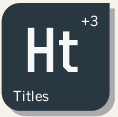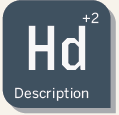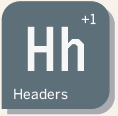HTML is the underlying code used to create web pages. Search engines can pick up ranking signals from specific HTML elements. Below, some of the most important HTML tags you should pay attention to.
Imagine that you wrote 100 different books but gave them all the same exact title. How would anyone understand that they are all about different topics? Imagine that you wrote 100 different books, and while they did have different titles, they weren’t very descriptive — maybe just a single word or two. Again, how would anyone know at a glance what the books are about.
HTML titles have always been and remain the most important HTML signal that search engines use to understand what a page is about. Bad titles on your pages are like having bad book titles in the examples above. Think about what you hope each page will be found for, especially relying on your keyword research. Then craft unique, descriptive titles for each of your pages. For more help about this, see our tutorial below:
One of the oldest supported HTML elements, the meta description tag allows you to suggest how you’d like your pages to be described in search listings.
SEO purists will argue that the meta description tag isn’t a “ranking factor,” in that it doesn’t actually help your pages get a boost to the top. Rather, it’s a “display factor,” something that helps how you look if you appear in the top results because of other factors.
Technically, that’s correct. Yet, as search engines are looking at things like engagement, whether your listing even attracts a click is a ranking factor. A good description can increase the odds of that click. So we feel the meta description tag should be counted as a ranking factor.
Having a meta description tag doesn’t guarantee that your description will actually get used. Search engines may create different descriptions based on what they decide is most relevant for the particular query that a listing is shown for. But it increases the odds that what you prefer will appear. It’s easy to do. So do it.
Below, Search Engine Land articles that take a closer look at the meta description tag:
Hh: Header Tags
See the headline up at the top of this page? Behind the scenes, HTML code is used to make that a header tag, an H1 tag in particular.
See the sub-headlines on the page? Those also use header tags. Each of them is the next “level” down, using H2 tags.Header tags are a formal way to identify key sections of a web page. Search engines have long used them as clues to what a page is about. If the words you want to be found for are in header tags, you might have a slightly increased chance of appearing in searches for those words.
Naturally, talk of header tag “boosts” has caused some people to go overboard. They’ll put entire paragraphs in header tags. That doesn’t help.Header tags are useful when they reflect some logical structure to a page. If you have a main headline, using an H1 tag makes sense. Subheads in H2 make sense. Use headers as they make sense, and they may reinforce some of your other ranking factors. Don’t use them, and that’s OK. They’re a minor factor, anyway.
 Ht: HTML Title Tag
Ht: HTML Title Tag
Imagine that you wrote 100 different books but gave them all the same exact title. How would anyone understand that they are all about different topics? Imagine that you wrote 100 different books, and while they did have different titles, they weren’t very descriptive — maybe just a single word or two. Again, how would anyone know at a glance what the books are about.HTML titles have always been and remain the most important HTML signal that search engines use to understand what a page is about. Bad titles on your pages are like having bad book titles in the examples above. Think about what you hope each page will be found for, especially relying on your keyword research. Then craft unique, descriptive titles for each of your pages. For more help about this, see our tutorial below:
 Hd: The Meta Description Tag
Hd: The Meta Description Tag
One of the oldest supported HTML elements, the meta description tag allows you to suggest how you’d like your pages to be described in search listings.SEO purists will argue that the meta description tag isn’t a “ranking factor,” in that it doesn’t actually help your pages get a boost to the top. Rather, it’s a “display factor,” something that helps how you look if you appear in the top results because of other factors.
Technically, that’s correct. Yet, as search engines are looking at things like engagement, whether your listing even attracts a click is a ranking factor. A good description can increase the odds of that click. So we feel the meta description tag should be counted as a ranking factor.
Having a meta description tag doesn’t guarantee that your description will actually get used. Search engines may create different descriptions based on what they decide is most relevant for the particular query that a listing is shown for. But it increases the odds that what you prefer will appear. It’s easy to do. So do it.
Below, Search Engine Land articles that take a closer look at the meta description tag:
- Google’s Tips On How To Write A Good Meta Description
- Meta Tag Optimization Tips: A Search Usability Perspective
- The Anatomy Of A Google Search Result
Hh: Header Tags
See the headline up at the top of this page? Behind the scenes, HTML code is used to make that a header tag, an H1 tag in particular.
See the sub-headlines on the page? Those also use header tags. Each of them is the next “level” down, using H2 tags.Header tags are a formal way to identify key sections of a web page. Search engines have long used them as clues to what a page is about. If the words you want to be found for are in header tags, you might have a slightly increased chance of appearing in searches for those words.
Naturally, talk of header tag “boosts” has caused some people to go overboard. They’ll put entire paragraphs in header tags. That doesn’t help.Header tags are useful when they reflect some logical structure to a page. If you have a main headline, using an H1 tag makes sense. Subheads in H2 make sense. Use headers as they make sense, and they may reinforce some of your other ranking factors. Don’t use them, and that’s OK. They’re a minor factor, anyway.
Chapters: Home 1: Factors 2: Content 3: HTML Code & Search Engine 4: Architecture 5: Links 6: Social 7: Trust 8: Personalization 9: Violations 10: Blocking

